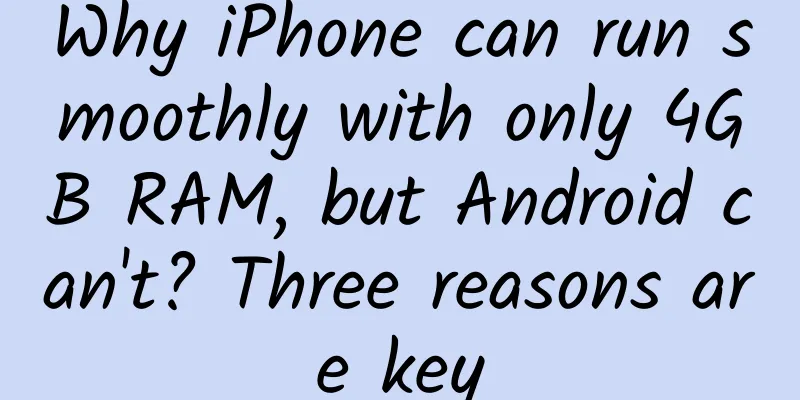Why iPhone can run smoothly with only 4GB RAM, but Android can't? Three reasons are key

The difference between iPhone and Android RAMMany people may not have noticed that the standard versions of iPhone 11, iPhone 12, and iPhone 13 all have 4GB of RAM, and it is LPDDR4X. Android flagships have long popularized 8GB of RAM, and it is LPDDR5 specification, such as Xiaomi 11. Even the thousand-yuan Redmi Note 11 has at least 6GB of RAM as standard. The capacity of running memory is the key factor affecting the service life of a mobile phone. In theory, the larger the better. For example, a mobile game requires 2GB of RAM when running, but the phone only has 3GB of RAM, and the system and background basic services take up nearly 1.5GB. In this case, the game will not run or will frequently crash. iPhone 8 cannot play Genshin Impact, but iPhone 8P can, because the RAM is 1GB lower. If the memory capacity is too small, it will also make it impossible for the background to hold multiple tasks at the same time, and the background must be killed frequently to free up memory. This makes it easy for us to feel a sense of lag during the switching process. This is what confuses many people: Why is the iPhone running smoothly with only 4GB of RAM, while Android phones, even those priced at 1,000 yuan, require at least 6GB of RAM? Three reasons are key. First, iOS has stricter memory managementFor example, Android allows apps to build their own background services, but iOS does not allow this, and all app notifications are sent to a unified push interface. In other words, installing or running the same number of apps on iOS will take up less RAM than on Android, because there are no background services taking up RAM, and 4GB can be used to the effect of 6GB. Second, iOS can fully utilize the hardware performanceiOS is developed using the highly efficient Objective-C language, which can be understood as a system that runs directly on hardware without any performance loss, bringing hardware performance to its maximum. Android is developed in Java and needs to be run with the help of a virtual machine. The advantage is good compatibility, but after the secondary conversion, there will inevitably be performance loss in the process. Third, iOS prioritizes screen touch responseThe iOS system responds to screen touch first, giving visual and sound effects first, and then activating the APP. Therefore, even if the iPhone 6 has only 1GB of RAM, you will only feel that the transition animation is slow, but you will not feel any lag. Android, on the other hand, activates the app first before responding to screen touches. The capacity of the running memory directly determines the fluency. After all, if the running memory is not enough, you have to kill the background before launching the APP, and the operation will be stuck on the first layer, resulting in obvious lag. Finally, let’s make a summaryIn short, 4GB is enough for an iPhone, but Android will lag without large RAM, and the above three reasons are the key. Therefore, the reason why Android phones have more RAM than iPhones is not because they feel guilty, but because they are forced to do so. The gap that is innate can only be made up through acquired efforts. |
<<: Google launches new Qaya service: Help creators easily build online stores
Recommend
The same age as the Party! He installed "eyes" on missiles and cultivated talents for the aerospace industry
All material civilization, including airplanes an...
How much does it cost to develop a mini program?
The editor still says the same things as before. ...
Will changes in clouds exacerbate global warming? Today, let's sit together and watch the clouds rise.
When we bask in the sunshine under a clear sky, w...
What time is it today? What month and day is Jingzhe? Here are some beautiful sentences to welcome the spring during the Jingzhe solar term!
What time is Jingzhe today? What month and day is...
Even if you have disabled or uninstalled the app, it will still automatically renew! Expert advice: You can turn off the automatic renewal of Alipay and WeChat
Nowadays, copyright awareness in the domestic mar...
Very interesting, how to view code as a crime scene
Measuring software complexity is a popular and co...
Zhong Nanshan recommends that Hong Kong conduct universal nucleic acid screening (full text)
Zhong Nanshan suggested that Hong Kong should car...
We catch colds twice a year, and the viruses we infect are different every 100 years丨Virus Super Topic
Cold is a general term for a class of diseases wi...
Tutorial on how to attract traffic with short videos on Tik Tok!
1. Register a short video platform account : If y...
Brand marketing strategy from 0 to 1!
What are the two most important methodologies dur...
30+ short and professional tips on how to become a better Android developer
[[201531]] It is easy to become an Android develo...
7 kinds of "aging agents" hidden in daily food, try to avoid them as much as possible!
This article was reviewed by Zhu Hongjian, Chief ...
Is your ear itchy and painful, and is oozing and crusting over? You may have acute otitis externa
We often encounter such situations in life: water...
What is the focus of brand marketing in 2021?
With the disappearance of traffic dividends, the ...









